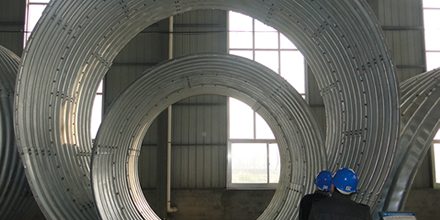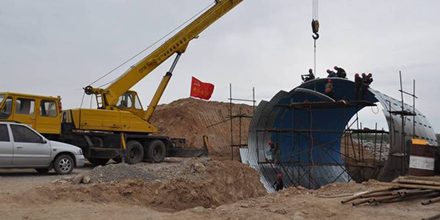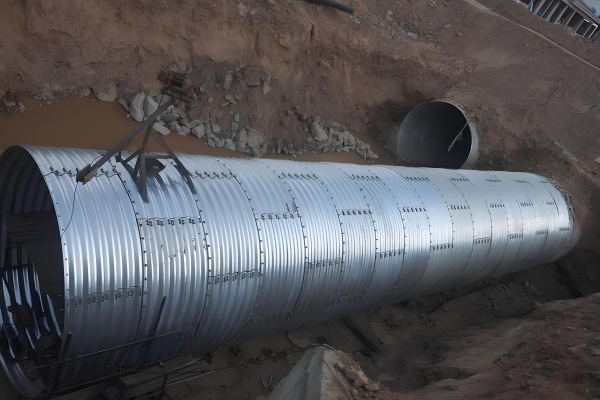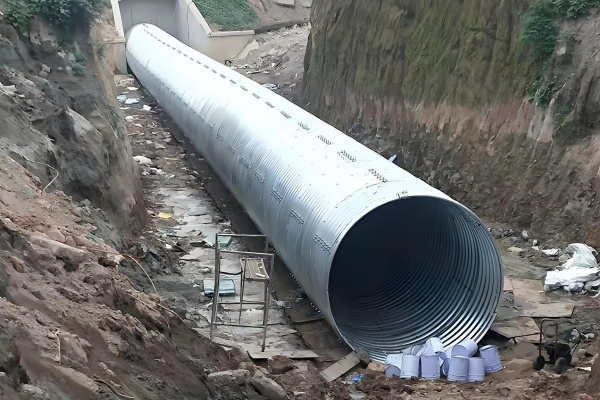Application Of Large Diameter, Long Distance And Assembled Corrugated Steel Culverts In Mountain Flood Control Project
As a new type of material structural , Corrugated steel culverts has the advantages of simple structure, fast construction speed , strong foundation adaptability compared with traditional culvert pipe structure.In recent years, their application in hydraulic engineering has expanded significantly.To provide reference for application of corrugated steel culvert in mountain flood prevention projects, This authors discuss about the structure calculation of corrugated metal culverts, differential settlement resistance, waterproof performance, and connection methods. And also introduce the application of large diameter-long distance-assembled corrugated metal culvert in the mountain flood project.
Currently, corrugated steel culverts is widely used in railway culverts, but and rarely used in hydraulic engineering. This discrepancy primarily stems from fundamental differences in operational requirements: highway drainage culverts typically feature straight alignments, short spans, single-direction flow paths, brief water conveyance duration, and relatively low waterproofing standards. Consequently, they seldom encounter challenges associated with large-diameter, long-distance corrugated metal culvert systems such as differential settlement management, pipeline directional changes, branch connections, or stringent anti-seepage requirements.
This paper presents a groundbreaking case study implementing prefabricated large-diameter, long-distance corrugated metal culverts in mountain torrent control projects. Through comprehensive technical analysis, we specifically address four critical aspects of corrugated metal culvert applications in hydraulic environments:
1).Differential Settlement Mitigation: Advanced structural adaptation techniques for longitudinal deformation contro
Enhanced Waterproofing Performance: Multi-layered sealing systems exceeding hydraulic engineering specifications
Specialized Fittings Integration: Customized branching units and directional transition components
Our research demonstrates that corrugated metal culverts possess significant untapped potential for hydraulic infrastructure applications. By resolving key technical challenges through engineered solutions, we establish a technical framework for expanding corrugated metal culvert utilization in water conservancy projects. It is hoped to strengthen the research on the application of steel corrugated culverts in hydraulic engineering and provide reference for the application of this type of pipe in hydraulic engineering.
Situated in a low-mountain basin in northern Shaanxi Province, China, this critical infrastructure project combats severe flood risks through advanced corrugated metal culvert technology. The region experiences:
1).Extreme Rainfall Variability: Annual precipitation fluctuations exceeding 60%
2).Concentrated Summer Storms: 78% of rainfall occurs June-August, with intense downpours reaching 98mm/hour
Flood Control Strategy Using Corrugated Metal Culverts,To ensure regional safety, engineers designed:
1).Mountain Interception System: 8.3km perimeter channels collecting hillside runoff
2).Dual Corrugated Metal Culvert Pipelines:Total length: 2.17km (longest continuous span)
3).Maximum flow capacity: 56m³/s,Foundation: Compacted artificial fill (7.5-15.6m thickness)
In order to ensure flood control safety in the project area, the engineering design is carried out along the surrounding area .Constructing flood interception channels on the mountain to collect surrounding floodwaters, and collecting the collected floodwaters Discharged into the downstream lake through two drainage pipeline.
The engineering design integrated hydrological and topographic conditions to calculate flow capacity, determining a 3.5m-diameter stormwater pipeline. Three pipe types were evaluated: reinforced concrete pipes, prestressed reinforced concrete pipes, and corrugated metal culverts (steel corrugated pipes)
Reinforced and prestressed concrete pipes offer advantages such as high pressure resistance, low roughness coefficients, and mature connection technologies. However, their heavy weight demands specialized hoisting equipment for installation. The project area’s artificial backfill foundation requires large concrete bases for pipe trenches, increasing construction volume and costs. In contrast, corrugated metal culverts demonstrate superior cost efficiency:
40% lower per-linear-meter comprehensive cost compared to concrete pipes for diameters over 3.5m.
High strength and pressure resistance.
Lightweight design for easy transport and on-site assembly.
Adaptability to complex terrains and rapid installation.
Given these advantages—particularly the 40% cost savings and flexibility in challenging topography—corrugated metal culverts were selected as the optimal solution.
3.1 Diameter Optimization
Market research revealed that corrugated metal culverts with adequate soil cover capacity fall into two categories:
≤3.0m diameters: Single-unit pipes.
>3.0m diameters: Modular assembly pipes.
Three diameters (3.0m, 3.5m, 4.0m) were analyzed to balance flow capacity and cost-effectiveness. Key design parameters:
Pipeline length: 2.17 km.Slope gradient: 0.04–0.06.
Roughness coefficient: 0.033 (referencing provincial highway engineering standards due to the absence of water conservancy-specific guidelines for corrugated metal culverts).
Flow capacity calculations incorporated:Hydraulic analysis of culvert flow regimes. Segment-specific variables (flow rate, diameter, upstream water level, length, slope). Integration of storage ponds and tributary inflows.
 Products
Products Application
Application



